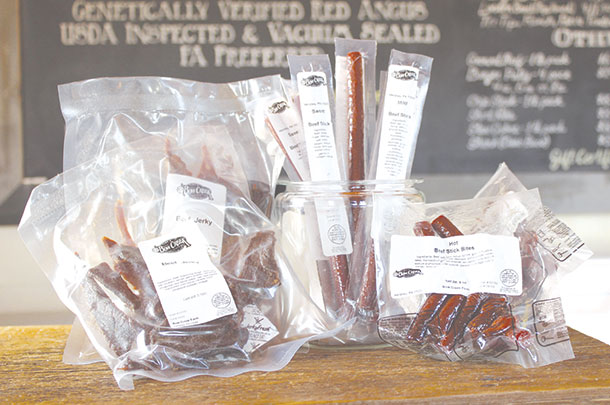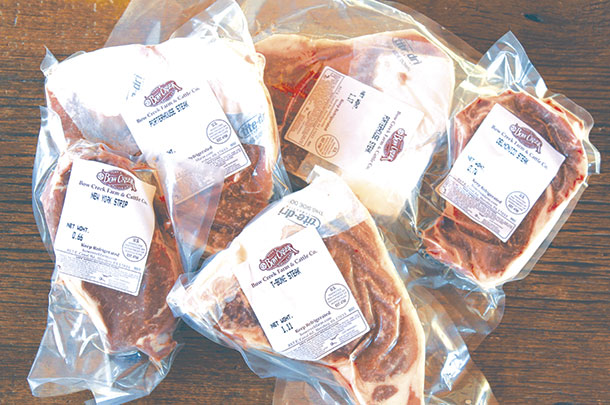Bow Creek Farm is operated by Rob and Amy Hess. The Hesses, who named their farm for the creek that runs through the property, operate approximately 400 acres in Hershey, Pennsylvania. They directly market approximately 60 head of Red Angus cattle and grow approximately 250 acres of hay.
The Hesses have been raising beef cattle since 1994, but as they’ve watched the beef industry change over the years, they foresaw an opportunity to differentiate themselves in the market by giving their beef a brand name.
Over two decades later, the Hesses now sell their beef to local restaurants and run a growing direct-to-consumer on-farm store. The Hesses attribute much of their success to the genetics of their Red Angus herd, but they have recognized the value a brand name can add to their business. After all, in order for a consumer to know to expect a premium beef product, they need to know its name first.
I sat down with Rob Hess to learn why branding is important to his operation and how other small beef producers can differentiate themselves from their competition.
Rob, thank you for taking the time to talk today. To get started, can you tell us a little bit about how you started producing and marketing beef?
HESS: We bought our first cows in 1994, but it wasn’t until 2005 that we started raising Red Angus, which is the breed we raise today. In 2010, a routine Red Angus Association audit changed our perspective.
The Red Angus representative pointed out that one of our cows was what he called “a phenotypically outstanding animal” and recommended that we consider flushing embryos from her.
Following his recommendation, we flushed embryos from that cow, and we’ve had great success marketing and selling the descendants of that cow as registered Red Angus.
We even sold one bull out of that cow to a prominent seedstock operation in South Dakota, Bieber Red Angus. It makes us proud that an East Coast beef animal was able to get into a program of that magnitude.
And when did you start using the Bow Creek name?
HESS: We registered some of our first breeding animals under the Bow Creek name. Having the name in place early on made it easier for people to identify who we were once we had more prominent breeding animals.

It was easy for us to choose our name because Bow Creek runs through our farm. It really could have been anything, but I think farmers and ranchers often make do with what we are given.
Do you think at the time you recognized how important your brand name would become?
HESS: I think we realized its importance just before we made our first sale to the Hotel Hershey, which was in 2011. I began to notice that there were some big names in meat production, but there was a gap in the local beef industry.
We knew that in order to command a premium for your product, you have to have an identity, so when I wrote that first letter to the Hotel Hershey, I used the Bow Creek name.
Of course, along with the identity, you have to have the story. You need to establish protocols and expectations for your customers. For us, that was easy because our farm is our story. My wife, Amy, and I have our hands full with breeding and selling, and we take pride in our genetics, so we don’t have much time to dedicate to building the brand.
We are just two people who are dedicated to producing premium Red Angus beef using progressive, selectively bred genetics. We have room to grow our brand, but I think it’s our story that resonates with people.
I think so, too. You mentioned selling to the Hotel Hershey. Can you tell us more about that?
HESS: I wrote a letter to the head chef at the Hotel Hershey in 2011 to see if they might be interested in purchasing locally grown beef. Luckily, they were actually looking for someone local to work with, so they called me in for a meeting.
It turned out they were having trouble finding someone who could provide a consistent supply to meet the demands of their customers. And even more challenging than a consistent supply, they needed a consistently high-quality product at that.

Amy and I felt we were up to meeting that challenge, in large part thanks to the dependability and consistency of our genetics. So that first year, we sold 15 animals to the Hotel Hershey, most of which was put onto the menu at their Harvest restaurant on-site. Now, we sell them around 35 animals a year.
Since they purchase the entire animal – not just primals and ground beef – they depend on us to sell them animals of similar size and weight each time, and they need the animals year-round rather than just one or two times per year. We manage inventory on our end carefully to make sure that our supply can keep up with their demand.
And I think we do a pretty good job at that, because we’ve had patrons of the hotel, people from out of town across the country, look up our Facebook page and give us positive reviews.
Speaking of Facebook, are there any other places where consumers can find the Bow Creek name?
HESS: Probably the most prominent place is our farm store. We started work on the store in December of 2017 and opened to the public in January 2018. Already, the store is on pace to increase our beef revenue by 50 percent this year, which we consider to be substantial.
Again, we attribute much of the success of the farm store to the genetic makeup of the animals we are feeding. We haven’t had one complaint about the product, so we believe that our premium product is meeting our customers’ expectations, and we have the genetics to thank for that.
That’s great news. Have you run into any growing pains since the Bow Creek brand has become more visible in your area?
HESS: I think the first thing that we could say as a word of caution to anyone considering this path is that it can be difficult managing inventory. Much like we have to be aware of when our cattle will be ready to sell to the Hotel Hershey, we need to carefully monitor our store inventory.
More specifically, we see that our steaks sell out almost immediately but we don’t sell ground beef or roasts at the same rate. We needed to have a plan in place to move additional ground beef, so we reached out to local restaurants to help with that. We brought on an additional restaurant to sell ground beef to, which has helped.
Do you have any final thoughts for producers who might be just starting their branding journey?
HESS: Just like we rely on our genetics to supply consistently premium beef to our customers, consistency is important to help your customers recognize your brand. For us, we want to supply a quality product to people close to us in central Pennsylvania, but it’s taken us a lot of hard work to get to this point.
We recommend staying true to yourself and to your brand’s story because that will help you enjoy the long road ahead of you. ![]()
PHOTO 1: Managing inventory for year-round beef demand has been one of the challenges for owners Rob and Amy Hess.
PHOTO 2: Jerky, beef sticks and steaks are among the product offerings at Bow Creek through the on-farm store. Branding their business has helped them gain a foothold in the retail markets.
PHOTO 3: Beef from Bow Creek is sold to high-end restaurants and through an on-farm store. Photos courtesy of Bow Creek Farm and Cattle Co.
Aimee Culbert is in communications with CNH Industrial America LLC. Email Aimee Culbert.







